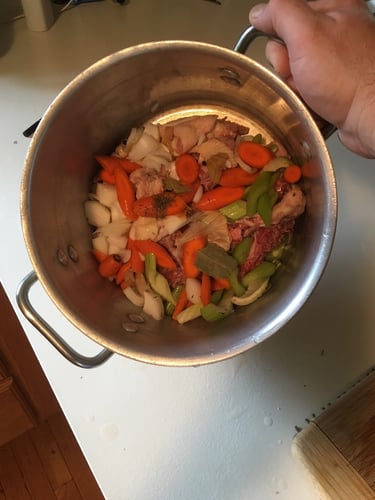I remember how my view of cooking completely changed when I learned what a stock was and how to make and use them. At Kendall College, I was taught a simple yet critical component to cooking that elevated all recipes to a new level.
Sure, a bouillon cube can come in handy for some flavor in a pinch. Canned broth can add some flavor to your dish, but often times that flavor includes the "canned" taste and a ton of sodium and preservatives. Some stocks have emerged which are mostly natural and can be a relatively healthy and flavorful substitute. Kitchen Basics® is one brand that I use when I don't have fresh on hand. But they never have as much depth and deliciousness as a homemade stock does!
Stocks can be made with a variety of ingredients: vegetables, bones, meat, spices, shells of lobsters and shrimp and many others. Ideally, you want to keep your stock flavor neutral. Avoid adding ingredients with strong flavors like ginger, garlic, mushrooms, peppers and other powerful ingredients. Instead, add those flavorings later when you make your sauce, soup or casserole.
Basic Chicken Stock
3-4 pounds chicken backs, wings with skin or a whole chicken cut into eight pieces
2 medium carrots, cut into large pieces
1 large celery stalk, cut into large pieces
1 large onion, cut into large dice
2-3 bay leaves
8-10 black peppercorns, whole
2-3 sprigs fresh thyme or 1 teaspoon dry
Water to fill pot
Rinse the chicken and remove any excess fat or giblets that may be still attached. Place in a large stock pot.


Simmer 4-6 hours, then strain the broth through a fine mesh strainer.
Cool rapidly over an ice bath.
Freeze in ice cube trays or small containers for future use. If cooled properly, stock will last several days in the refrigerated.
Or use the stock to make an awesome batch of chicken soup, like I did!
Important Notes:
- The 3 vegetables in stocks are referred to as "mire poix" (pronounced "meer pwah") and are usually 2 parts onion 1 part carrot, 1 part celery. This is ideal for every stock.
- The 3 spices in stocks are generally referred to as "sachet d'epice" or "bouquet Garni" and may sometimes include parsley stems. This is ideal for every stock.
- Any type of onion is a fine substitute for stocks. Leeks, shallots and scallions are also good choices.
- Vegetable scraps are great for stocks. Wash your carrots, celery and onions and use the peels and ends in your pot instead of cutting new vegetables.
- Stock is great as a replacement to water in many recipes like soups, rice, casseroles, cooking or poaching liquid and sauces!
- Keep salt out of stocks. Add it later when you use the stock in your recipes.
- Make a large batch when you make stock and freeze most of it in small portions for future use.
- Rapidly cooling your hot stock before storing it in the fridge is the most important step to the quality of the stock and how long it will stay fresh. It also protects your fridge and other ingredients inside from warming up.
- Don't boil your stocks! Large, rapid boiling bubbles cause particles to break off of the vegetables and re-incorporates fat into the liquid. This will result in a cloudy stock. Maintaining the lowest simmer possible will yield a much more clear final product.
The Chopping Block has courses like our Culinary Boot Camp that teach you not only the basics, but advanced techniques in stock, soup and sauce making as well. You'll learn the same tricks and techniques the pros use every day.
